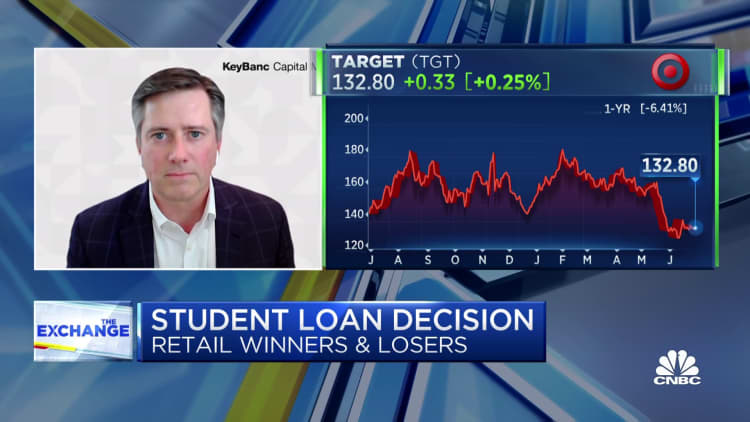The average sticker price for college, or published costs for tuition and fees, has been rising — but most families don’t pay full price.
Tuition, fees and room and board — plus books and supplies, transportation and personal expenses — total an average $27,940 at a four-year, in-state public college for the 2022-23 school year, according to the College Board, which tracks trends in college pricing and financial aid.
In total, the equivalent annual cost for a four-year private college is $57,570 on average. At some private universities, the total cost of college is more than $80,000 a year.
Yet, a new report from Sallie Mae finds the amount families actually spent on education costs last year was $28,026 on average, up 11% from the year before.
Families took out loans and borrowed money to cover about 21% of the costs. About 29% of college costs were covered by scholarships and grants, while the students’ and parents’ income and savings covered about half, according to the report.
As the mother of a first-year college student and a junior, too, I know that thinking about college bills is daunting. Here are three strategies that can help you pay for college now and save for rising costs in the future.
1. Tap college savings accounts as much as possible
Gerville | Istock | Getty Images
Saving as early as possible in state-sponsored, tax-advantaged 529 savings accounts lets your savings grow tax-free, as long as the money is spent on qualified educational expenses. Last year, about 30% of parents used college savings plans such as 529 plans to pay for about $7,800 of college costs, on average, according to the Sallie Mae report.
Money in 529 plans can be used tax-free for most education expenses, including tuition, room and board, books, computers and supplies at most two- and four-year colleges as well as technical, vocational and graduate schools.
“The benefits may outweigh any future reduction in aid,” said Adam Nguyen, founder of Ivy Link, a college admissions advising firm. “Benefits include the wide variety of education expenses that the funds could be used for.”
Starting in 2024, unused funds in 529s [can] be rolled into Roth IRAs, subject to certain exclusions.
Adam Nguyen
founder of Ivy Link
The 529 plan money also can be used to pay for up to $10,000 a year in K-12 tuition for primary or secondary public, private and religious schools, and even homeschooling.
“Moreover, starting in 2024, unused funds in 529s [can] be rolled into Roth IRAs, subject to certain exclusions,” Nguyen said, referring to a provision in a new federal law that passed last year.
If college is more than a decade away for your child or they’re getting close to the finish line in high school, there are college calculators online that can help you figure out how much you need to save in a 529 plan each month to pay for all or part of college costs at an in-state or out-of-state public institution or private college or university.
2. Leverage private scholarships
“For high school juniors and seniors, now is the time to continue to focus on your coursework — the rigor of your courses, as well as how you’re doing in them,” said Rob Franek, editor in chief of The Princeton Review, a test prep, tutoring and college admissions services company. “Those courses, along with SAT and ACT scores, unlock admission and scholarship dollars for the majority of schools.”
There are more than 1.7 million private scholarships and fellowships available, often funded by foundations, corporations and other independent organizations, with a total value of more than $7.4 billion, according to higher education expert Mark Kantrowitz.
Check with the college, high school counselors and local nonprofits for potential scholarships. Also, search websites such as Scholarships.com, Fastweb.com and the College Board’s Big Future site.
You could try to negotiate for more merit aid if you got more money from another school. “The outcome will be highly dependent upon factors like your academic caliber and other offers you might have received from colleges of a similar standing,” Nguyen said, adding that ideally, “this should be done before you accept your offer to attend.”
3. Appeal for more financial aid
It’s down to the wire for the coming academic year, as many college students may have already started classes, but it may not be too late to appeal for more financial aid.
For families who remain concerned about making ends meet based on the financial aid award they’ve received, it is possible to ask the college financial aid office for more aid. Aid for the 2023-24 academic year is based on 2021 income. If your circumstances are now different, that should be brought to the financial aid office’s attention.
If you’ve experienced a change in your financial situation, such as a job loss or a disability, contact the college’s financial aid office and send an appeal letter. Check out free templates online that can help you write it.

“This is still a time given a family’s financial situation, if things have changed dramatically from even just a few months ago, without question I would reach out to the admission and financial aid team,” Franek said.
If you didn’t apply for financial aid this year, it’s also not too late. Students miss out on billions of dollars in federal grants because they don’t fill out the Free Application for Federal Student Aid. Some schools may also require you to fill out the CSS profile on the College Board website to get access to nonfederal institutional aid. You have until June 30, 2024, to submit a FAFSA form for the 2023-24 school year.
Since the FAFSA is for a single academic year, you have to submit this form every year. The U.S. Department of Education says a revised FAFSA for the 2024-25 school year will be available in December of this year.
SIGN UP: Money 101 is an 8-week learning course to financial freedom, delivered weekly to your inbox. For the Spanish version Dinero 101, click here.

